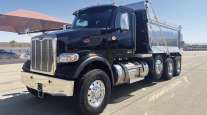Survey Finds Fewer Technical Problems With 2009 Trucks Than Previous Year
This story appears in the July 11 print edition of Transport Topics.
Owners of 2009 Class 8 trucks reported a drop in mechanical and technical problems from the previous year, including problems with engines, usually the largest source of complaints, J.D. Power and Associates said in a report.
The 2011 Heavy-Duty Truck Customer Satisfaction Study is based on responses from 1,651 “primary maintainers” of heavy-duty trucks, but it did not include rankings in the over-the-road segment because of insufficient feedback in that category, J.D. Power said June 30.
J.D. Power measures truck performance by counting problems per 100 trucks, or PP100.
“Overall product quality . . . improved by 29 PP100 this year, declining from 233 PP100 [in 2010] to 204 PP100,” Brent Gruber, senior manager of the commercial vehicle practice at J.D. Power, told Transport Topics.
“The greatest improvement was in the ‘frame/chassis’ category, which declined from 28 PP100 in 2010 to 19 PP100 this year,” Gruber said. “The biggest frame/chassis improvements were [in the] ‘exhaust stack,’ ‘exhaust system’ and ‘muffler, exhaust system’ [categories].”
J.D. Power, Westlake Village, Calif., said the survey was conducted in April and May on trucks that were in service between 13 and 18 months, classified as “model year 2010” and built in 2009.
“The second-most improved problem category this year is ‘engine,’ which declined from 72 PP100 last year to 66 PP100 this year,” Gruber said. “Engine is the most problematic category for truck quality, as measured by our study. “
He said the biggest engine improvements were with calibration of the electronic engine controls, the fuel-injection controls and the exhaust gas recirculation valve.
Reported problems in the 2011 survey decreased by 23% from J.D. Power’s 2006 report, the company said.
“Among trucks in service between 13 and 18 months, problems have decreased by 23% during the past six years, declining to an average of 198 problems per 100 trucks in 2011 from an average of 257 PP100 in 2006,” the report said.
Navistar Inc.’s International truck ranked highest in the pickup-and-delivery segment, improving from second position in 2010, J.D. Power said. Gruber said that this category includes trucks in the regional-haul market.
In the vocational truck segment, Peterbilt Motor Co. ranked highest and performed “particularly well in the engine and cost of operation factors,” J.D. Power said.
Kenworth Truck Co., like Peterbilt a Paccar Inc. company, received the top ranking in the dealer service category, followed by Peterbilt and Freightliner, a division of Daimler Trucks North America.
“We saw this trend in regional haul coming, knowing more and more customers in the industry are shifting toward regional-haul applications, and we invested in trucks, ProStar, TranStar and DuraStar, and 13-liter engines to provide the right combination for the market,” Jack Allen, president of Navistar’s North American Truck Operations, told TT.
“Technical and mechanical problems are identified via multiple feedback channels, including metric tracking, direct customer contacts, data mining and production feedback,” Dale Barker, reliability engineering manager for Daimler Trucks North America, told TT. “New designs and product launches incorporate the improvement ideas that come out of the problem-solving efforts. The end result is fewer technical and mechanical problems, and higher customer satisfaction.”
Mack Trucks Inc., a Volvo AB company, said that experience helped improve engine performance.
“By 2009, we had significant experience with our Mack MP engines and felt very good about the direction of our product offerings,” Kevin Flaherty, Mack Trucks Inc.’s senior vice president for the United States and Canada, told TT. “We expect future reports will continue to reflect the very positive results our customers are experiencing.”
Gruber said that the 2012 survey would be the company’s first assessment of 2010 model engines.
“In years following the launch of new engines in which technology was driven by the need to meet emission regulations, customer satisfaction declined and problems rose,” Gruber said. He said that J.D. Power reports on trucks built in 2004 and 2007, both with engine changes to meet federal emission requirements, showed sharp fall-offs in customer satisfaction and a rise in problems, especially with engines Peterbilt and Kenworth responded with written statements.
“Peterbilt’s vocational vehicles consistently exceed customer expectations in a wide variety of configurations and applications.” Bill Jackson, Peterbilt general manager, said.
“Kenworth is honored to receive the . . . Heavy Duty Dealer Service Award from J.D. Power and Associates,” Gary Moore, Kenworth’s general manager, said.
Gruber said the ramp-up in production this year also was a cause of concern.
“In recent years, commercial vehicle manufacturers and suppliers have made great strides in improving the quality and reliability of heavy-duty trucks, but the focus will quickly turn toward maintaining these levels at a time of increased production volumes and the release of 2010 EPA-compliant engines,” Gruber said in a written statement accompanying the report.




